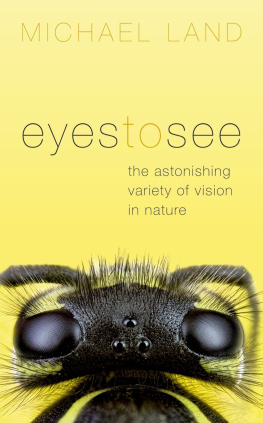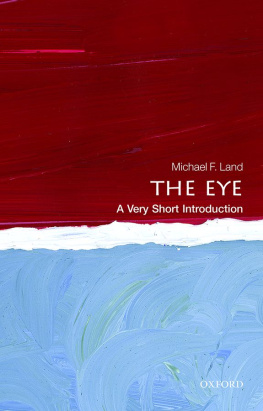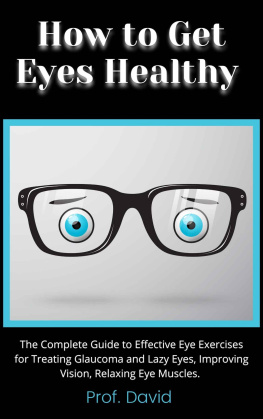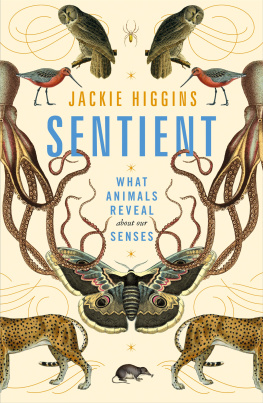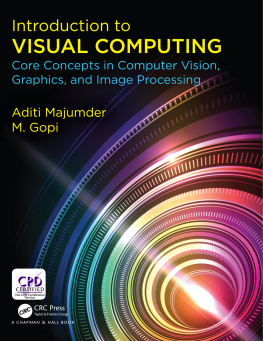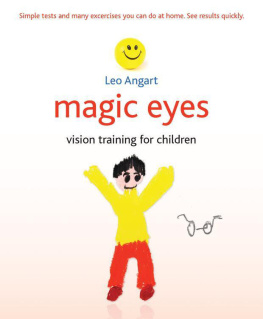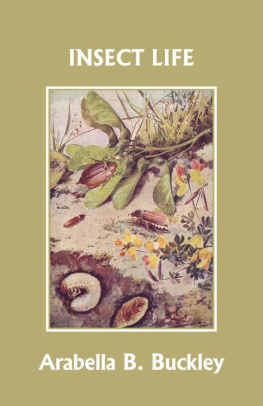Eyes to See

Great Clarendon Street, Oxford, OX2 6DP, United Kingdom
Oxford University Press is a department of the University of Oxford. It furthers the Universitys objective of excellence in research, scholarship, and education by publishing worldwide. Oxford is a registered trade mark of Oxford University Press in the UK and in certain other countries
Michael F. Land 2018
The moral rights of the author have been asserted
First Edition published in 2018
Impression: 1
All rights reserved. No part of this publication may be reproduced, stored in a retrieval system, or transmitted, in any form or by any means, without the prior permission in writing of Oxford University Press, or as expressly permitted by law, by licence or under terms agreed with the appropriate reprographics rights organization. Enquiries concerning reproduction outside the scope of the above should be sent to the Rights Department, Oxford University Press, at the address above
You must not circulate this work in any other form and you must impose this same condition on any acquirer
Published in the United States of America by Oxford University Press 198 Madison Avenue, New York, NY 10016, United States of America
British Library Cataloguing in Publication Data
Data available
Library of Congress Control Number: 2018944716
ISBN 9780198747710
ebook ISBN 9780191064869
Printed in Great Britain by Clays Ltd, Elcograf S.p.A.
Preface
The study of vision spans most divisions of science. Physics is involved in the optics of image formation, and chemistry in the way light energy is converted to nerve activity. The biology of animal vision is a vast subject, as different animals use sight for many different purposes, from simple navigation to recognizing individuals. The nature of human vision has attracted philosophers since antiquity, and modern psychologists have explored the processes of perception through experiment, and more recently, by techniques such as brain scans. There is much more to find outwe still dont even know how to ask the question Why does red look red?
In fifty years working on vision, I have had contact with, and sometimes immersion in, many aspects of the subject. I began by studying some of the more unusual eyes of invertebrates, and after a meandering journey through the animal kingdom, found myself working on the ways that people use eye movements to find the information they need to do things. I suppose that at different times, I have been an applied physicist, a physiologist, an ethologist, and a psychologist, but I did manage to avoid most chemistry. Im happy to admit that this diversity of interest was no accident. At school my best subjects were physics and biology (these coincided with the best teachers). My main hobby was photography. It seems that the child was indeed the father of the man.
In this book I have selected those aspects of eyes and visual systems that have intrigued me most, in the hope that I can convey some of the joy that I have had in the study of them. This is not just my story: there have been many otherscolleagues, students, and people I have never metthat have contributed to the milieu in which I worked, and I have drawn them into the narrative. I have always studied the things that seemed most interesting to me at the time, so my progression in the field has been opportunistic rather than logical. However, in the book, I have tried to organize the chapters into related themes, to provide a reasonably coherent framework.
It is a pleasure to thank the staff at Oxford University Press and in particular, my editor Latha Menon. She suggested that I write the book, she has read and greatly improved the text, and has guided its progress through to publication.
Contents

I am going to begin this book, unashamedly, by writing about my first proper scientific discovery, which I still regard as an extraordinary piece of good luck. As a beginning postgraduate student at University College London, I had managed to persuade John Gray, my supervisor, that scallops would be a good animal to study. Unlikely as this seems, it was more than just a whim. Around the inner margin of a scallop shell is the mantlethe bit you dont see at the fish shopand this contains a mass of sensory tentacles, embedded in which are about sixty rather pretty eyes, each about a milli-metre across (). At the time it was not the eyes themselves that attracted me, but the fact that there were a lot of them, feeding into a single central ganglion attached to the large and very edible muscle. Why so many eyes? What were they telling the brain? What use did the brain make of this information in organizing the animals behaviour? There was clearly a puzzle here. My idea was to record the electrical activity in the nerves from the eyes to the ganglion, record the output to the muscle, and then record from the cells in the ganglion to work out what processes triggered a response. Scallops dont do a lot: their main behaviour is to shut when things approach.
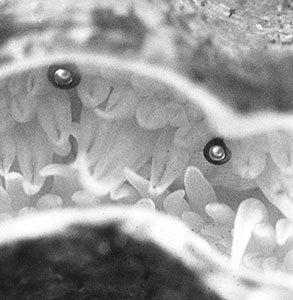
Fig. 1. Two eyes of the scallop Pecten maximus looking out between the tentacles of the mantle edge. The eyes are a millimetre across, and the images of some of the lights in the room are visible in the pupils.
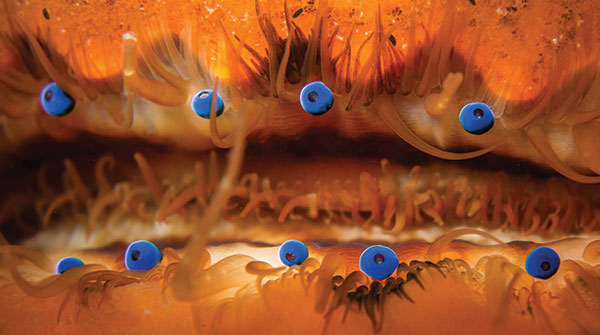
Plate 1. Blue eyes of the Atlantic bay scallop (Argopecten irradians) looking out between the tentacles of the mantle. The sixty to one hundred eyes are each about 1 mm in diameter, and they cause the animal to shut if they detect objects such as fish moving nearby.
John Gray was a sensory physiologist who worked on vertebrate touch receptors, but he liked the scallop idea and gave me much advice and help, though he left part way through my Ph.D. to become secretary of the Medical Research Council. This resulted in a heart attack and a knighthood, and he retired to Plymouth, where he continued to work on fish hearing for another 30 years.
Before getting too deeply involved in the dark arts of electrophysiology, I had to work out how the scallops eyes worked. There were plenty of existing descriptions, and from these one could conclude that scallop eyes were conventional, with more or less the same layout as a fish eye, with a lens, a retina, and a reflecting mirror-like layer behind the retina, much as in the eye of a cat (). I waved my hand and the image mirrored my action. I didnt initially think much of this, because, after all, eyes are supposed to contain images. But after a while it dawned on me that something was wrong. If you look into a human eye, you cant see an image within it, because you are trying to see the image through the same lens that formed it. What this means is that the image on the human retina, seen from outside through the lens, is back where the object wassomewhere a long distance outside the eye, and very definitely not in it. (You can see the image in the human eye with an ophthalmoscope, but that instrument contains a lens system that neutralizes the power of the eyes optics, allowing the retina to be viewed directly.)

